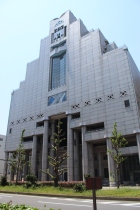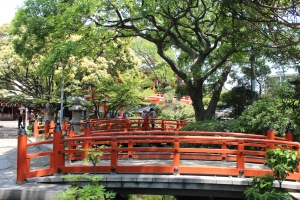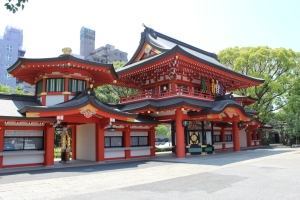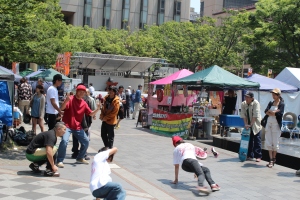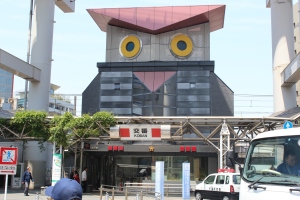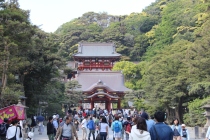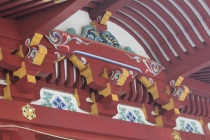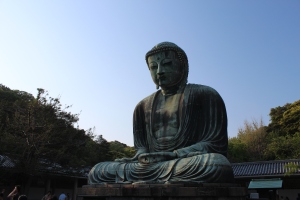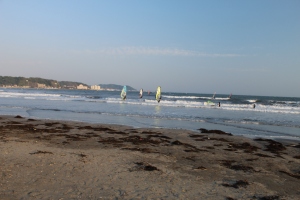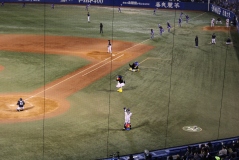can we find tranquillity
out in brash Hong Kong?
Sorry for the hiatus any anxious readers but family fun in Hong Kong, travelling back to London and going straight back to work have interrupted the blogging process. This one will describe the four days we spent in Hong Kong and then there will be occasional posts and new pages with extra photographs and details of some of the highlights of the trip.
So after a Thursday to forget (except for home cooked dinner by Tom) we wake up at their amazing apartment on the 27 th floor with views to the harbour on one side and over the whole of the Happy Valley race course and sports area from the living room. I was impressed by Hong Kong thirty years ago. Now most of the buildings I saw have been demolished and replaced by even taller ones. It is a truly phenomenal city in the sky. If you’ve ever played SimCity you’ve been to Hong Kong! We spent the morning exploring Central – walking through the clammy streets, up the huge travelator that swoops up to the Mid Levels and then through the air conditioned malls and walkways that enable you to survive in the city. 27 degrees and 97% humidity make air conditioning not a luxury but a necessity. And by careful planning you can go most places in comfort. Tom, now a HK veteran of two years has it all sussed so we move through the city cool, calm and collected. We then make our way back to Causeway Bay to see a Hong Kong institution – the Noonday Gun. This is a tradition carried out since the 1860s when Jardines, one of the major Hong Kong trading companies was ordered by a British naval officer to fire a one gun salute at noon every day as a punishment for insulting the navy by saluting a civilian.
Synchronizing watches and bang!
We arrived and took up our positions, watched the gunners carefully check their watches and then jumped like mad when a very loud report and a big puff of smoke issued forth. Even though you know it’s coming, it’s still a real shock. We then walked round to the Royal Hong Kong Yacht Club one of the most sought after memberships in the territory. We are very lucky in that Paul Dalton, a good friend of Tom and Caroline, whom I had met in London, had invited us for a relaxing elegant lunch. Feeling very privileged, we enjoy fabulous views of Victoria Harbour and partake of food from an interestingly mixed buffet and menu which combine British colonial favourites with local specialities. Lunch was unhurried, conversation flowed and ranged over many issues and the whole was presided over with graceful charm by Paul. As we left, the famous Hong Kong rain came down, hard and vertical and, as elsewhere in the world, dissolved all trace of taxis from the streets. Eventually one parted the curtain and took us away for a little light sightseeing and then back to the apartment for a break which included watching the most incredible clouds pour down over Happy Valley.
We then changed for the evening which was at an equally interesting venue – the China Club. It appears not to have a working website but has an intro and picture in its sister club’s site for Singapore. Set in the former headquarters building of the Bank of China it’s a retro eye-opener with stair and landing walls lined with modern art from owner Sir David Tang’s collection – an eclectic taste is displayed. There’s a roof terrace with fabulous views over night time Hong Kong and a vast dining room with superb food and a series of fascinating shows – a torch singer who whispers jazz classics, not always quite in tune but certainly the centre of attention. She is followed by two guys – one doing amazing things pouring tea from a very long teapot into cups that he’s juggling while contorting his body; the other makes fine noodles from a massive slab of dough by repeated slapping and pulling. Amazing. 




Apart from the club’s entertainment, a highlight was the chance to catch up with Steve and Michelle Resco. Dee and I had worked closely with Steve in helping to establish the Watford Supporters’ Trust ten years ago. It was Steve who engineered our viewing of Watford v Leeds in Roppongi the week before and it was great to catch up with lives lived all over the place since we last spent time together. Home for a nightcap and a lengthy sleep. Saturday took us for a wander through the wet markets of Causeway Bay an easy walk down from the apartment. Eyeballs were stretched by the sheer volume of food of every kind being chopped, skinned, sliced and in some cases slaughtered right there on the street. One aspect of Hong Kong eating became abundantly clear – whatever you selected it was amazingly fresh – fish still flopping not frozen – one even jumped off the slab and was retrieved by an unfazed Chinese senior citizen. 

We walked on to meet up with Caroline who had to go to work in the morning but was able to join us for a splendid lunch at one of their favourite restaurants Din Tai Fung. Of Taiwanese origin, it serves a mixture of dim sum style dumplings, buns and wan ton, excellent dan dan noodles, cucumber with chilli and garlic and the best ever egg fried rice as Tom had promised. I had loved Hong Kong’s trams thirty years ago so we took a ride along to the Star Ferry.
Crossing the harbour on the ferry is an essential part of any visit to Hong Kong and once again it didn’t disappoint. We made the journey across to Kowloon, passing the large inflatable Rubber Duck – Florentijn Hoffman’s installation which has mysteriously deflated since our visit – not guilty m’lud. We then make our way to the ICC Tower and go up to the observation deck. Despite a certain murkiness in the distance the views are fabulous and we were reminded that at 484 metres high it’s the tallest building in Hong Kong and the fifth tallest in the world rather dwarfing London’s Shard at 309 metres. We also look down on one of the most densely populated areas of land in the world.
On descending I caught the Airport Express out to Chep Lak Kok to collect my phone, miraculously delivered to Hong Kong from Tokyo through the combined efforts of Japan Rail’s Narita Express, China Eastern Airways and Jardine handling staff in Hong Kong. I sign for it, switch it on and, goodness it works. So I text Tom to tell him I’m homeward bound and he advises the subway and a brief walk when I make it back to Hong Kong island as the traffic is mad and they are not even home yet. The MTR – Hong Kong’s subway – seems very efficient during my brief encounter with it. The only problem as in Tokyo, was that you seem to have walked at least far enough to reach your final destination but you’ve just been travelling through a vast underground interchange. My next walk was a little warmer as I followed Tom’s excellent texted directions to get myself from Causeway Bay station back to the Leighton Hill apartment to be rewarded with a cold beer for my efforts. After a brief rest and a change we set off by taxi for another fabulous evening. Tom and Caroline won’t be able to be in the UK in July so very kindly took us for a joint birthday dinner at Spoon, Alain Ducasse’s Michelin starred restaurant at the Intercontinental Hotel back in Kowloon. A brilliant tasting menu with matched wines proved a great choice as course after course arrived with delicious aromas and tastes. The whole occasion was enhanced by our prime window table from which we could watch the nightly Victoria Harbour Light Show. Produced by Hong Kong Tourism it was eagerly anticipated by the crowds below us on the waterfront. The light patterns on individual buildings and the lasers flying between them make it look as if the city is holding a conversation between the huge towers that line the harbour. What a fabulous birthday present!
Sunday meant an early rise to go to Deepwater Bay to support Tom and his dragon boat racing team The Seagods. Tom took up dragon boating soon after moving out two years ago and has international medals for his efforts. And what efforts they are! Watching twenty men and women striving to move this great boat through the water from a standing start shows raw energy at work at its best. And it pays off as the Seagods comfortably win their first race with the A boat. An hour later Tom again plays a part in bringing the B boat in as runner up in a further heat. The sight of the beach covered with team tents, paddlers and their supporters is colourful and constantly moving as teams make their way to and from the start and finish pontoon.
Tom had made his apologies to the Seagods for only completing two races out of a possible five today in order to take us to explore the island further. We went to Stanley which feels much like Brighton, with narrow-laned markets, a promenade with pubs and restaurants and a pier which was reconstructed here from its original position in Central in 2006 along with the Murray House also originally built in Central in 1844 as Murray Barracks. They fit the landscape well and look as if they might always have been there.
We had the opportunity to share a drink with Katie, Tom and Caroline’s friend, who had given us so much good advice for our trip which was great as we were able to thank her in person, not just by email, for her insights. Katie had to go off elsewhere and so couldn’t join us for lunch in Saigon, an excellent Vietnamese restaurant in the Murray Building. After lunch we wandered around the headland to the Tin Hau Temple commemorating the goddess of the sea. It’s cut into the rock and was obviously a popular pilgrimage destination. We then returned to the much larger Man Ho Temple on the edge of Stanley Plaza where Lamborghini’s 2013 Cow Parade has raised considerable sums for charity.
After a great day out by the sea we decided on a simple dinner at home and a serious spell of packing for Dee and myself so we went back to Happy Valley taking in architect Frank Gehry’s first residential project in Asia Opus, a fabulous twisted tower that looks as if it has survived an earthquake. Its lines flow out of the steep hills that characterize Hong Kong island and for those wealthy enough to be inside must provide stunning views. After a trip to the butcher we then walk home through the middle of the Happy Valley racecourse which is busy with sports activity of all kinds. 
 It’s great to spend another evening at home with Tom and Caroline not least because Tom managed to find a website streaming Sky Sports coverage of the second leg of Watford’s play off against Leicester. And what a match that was with what has been termed “the greatest comeback ever in the world of football” with its double penalty save and brilliant counter attack for the winning Watford goal. Having missed out on the end of the season at least we’ll get one more game this season – at Wembley. Come on You Orns!
It’s great to spend another evening at home with Tom and Caroline not least because Tom managed to find a website streaming Sky Sports coverage of the second leg of Watford’s play off against Leicester. And what a match that was with what has been termed “the greatest comeback ever in the world of football” with its double penalty save and brilliant counter attack for the winning Watford goal. Having missed out on the end of the season at least we’ll get one more game this season – at Wembley. Come on You Orns!
I don’t know what it is with travel days but, as we retired early ahead of a six o’clock taxi departure for the airport, I confidently set the alarm on my newly recovered phone for 05:00. To our horror we are rudely awakened very soon after retiring. We get up, shower quietly and attend to final bits of packing. As I go to make a coffee I notice the kitchen clock blinking 04:20 at me. My phone was still on Tokyo time – an hour ahead of Hong Kong. Oops again. We set off as planned, are seen off by Tom and have excellent flights with Singapore Airlines back to Heathrow. The leg from Singapore to London was on the A380 double-decker plane about which Dee had worked on a documentary a few years back and had actually been in Toulouse for its maiden flight. The upper deck is all business and first class and they wouldn’t even let us go up and peek but never mind. A pre-arranged taxi met us at the airport and whisked us home in time to see that our Wembley opponents will be Crystal Palace, retire and prepare for work the next day.
It has been a wonderful month and one we won’t forget with its food, friendship and fascination allied with our quest to find out more about Murakami’s Japan. I think the trip can be called a success. We’ve enjoyed sharing it and getting your reactions and comments.






































